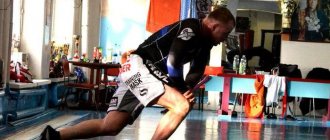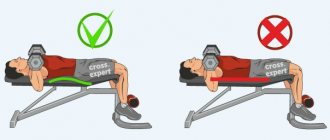Swimming and running, cycling and skiing require the ability to perform monotonous physical work for a long time. This quality is called muscle endurance. Increasing it is a difficult task, requiring the use of not only training tools, but also special recovery methods. In professional sports, the endurance period is approximately half of the annual cycle. At other times, athletes work on speed, strength, and technique. In amateurs, the figure can increase to 2/3, since beginners come with very weak performance. Endurance is useful not only in sports, but also in everyday life - walking several stops, climbing to the 8th floor without an elevator and walking with your child all day.
How quickly does endurance drop without training?
Pretty fast. “Much faster than muscle mass,” notes Oksana Khodorovich, personal trainer, group program instructor at the Escalada fitness club . —Endurance adaptation alters the metabolic environment in cells without the need for global tissue remodeling that is required for strength adaptation. You quickly get into shape, maintain it without problems, but it disappears just as easily.”
How quickly does stamina decrease? The experts' conclusions are disappointing. “It happens differently for everyone. Many researchers in the field of sports physiology agree that the first signs of loss of endurance are noticeable after 7-10 days of inactivity, comments Oksana Khodorovich. “During these days, the ability to move for a long time at low or medium intensity drops by 3-5%. As doctors discovered, first of all, the ability of the cardiovascular system to perform such work decreases. That is, you can either move slower by this 3-5%, or at the same speed your heart rate will be higher by 3-5%. After three weeks this difference will be 10%, after four – 14%.”
That's why it's important to train and develop your endurance at home .
What types of endurance are there?
There are several types of endurance.
Cardiovascular (or cardiovascular endurance). “It ensures long-term functioning of the heart and blood vessels during vigorous physical activity. Cardio training develops her: running, jumping, cycling, aerobics,” says Maxim Kurbatov. At home, this can also be running in place, performing a set of exercises at a fast pace, using cardio equipment (stepper, ellipsoid, etc.).
Muscular. “It depends on the number of continuous contractions of muscles and their groups. To develop it, multiple repetitions of exercises are necessary: squats, lunges, push-ups, crunches, etc.,” adds Maxim Kurbatov.
Trainers recommend developing both types of endurance - this will increase the effectiveness of exercises and make everyday activities easier.
Standing Alternate Dumbbell Press
The weight of the dumbbells is the same as that used in the first exercise. Tighten your leg muscles in advance by bending your knees slightly, and also focus on tightening your core muscles. So, your back is straight, your shoulders are slightly pulled back, after inhaling, as you exhale, press one dumbbell, then as you inhale, the dumbbell lowers to its original position and the movement begins with the second dumbbell.
Is it possible to develop endurance at home?
Of course you can. “The development of endurance is, to a large extent, the development of biochemical processes that contribute to longer work performance, as well as the resistance of the nervous system to high-intensity stimulation,” notes Oksana Khodorovich.
According to Oksana Khorovich, the physiological basis of endurance is the following processes:
- aerobic mechanism (carried out due to the oxidation of fats, carbohydrates and partially proteins);
- anaerobic-glycolytic (provided by the breakdown of carbohydrates in muscles and the formation of lactic acid without the participation of oxygen);
- anaerobic-alactate (associated with the breakdown of creatine phosphate).
All these processes are launched in our body with the help of active training. Accordingly, in order to develop endurance at home, you need to regularly introduce cardio into your regimen.
What workouts help develop endurance?
Aerobic exercise. “They allow you to strengthen the cardiovascular system, cardiorespiratory system, and reduce body weight. I would call aerobics, running and swimming the best activities in this category,” says Maxim Kurbatov.
Speed training. “These include almost all exercises that we perform at maximum speed, as well as circuit training,” adds Maxim Kurbatov.
Special training develops functional muscle endurance. “Such loads are recommended for professional athletes in a certain sport that requires the endurance of a specific muscle group,” notes Maxim Kurbatov.
At home, you can use circuit and aerobic training to develop endurance.
Everything you need to know
Endurance depends on three parameters:
- The ratio of muscle fibers in the athlete's body. Those athletes who have more “slow” fibers are naturally more resilient;
- VO2 max or oxygen uptake rate is a parameter that measures how quickly redox reactions occur in the body. This parameter is determined genetically, but is trainable. High-intensity interval training, such as alternating sprints and long recovery periods, or even circuit training, can increase this parameter;
- Lactate or anaerobic threshold is a parameter that determines at what level of load the athlete’s body begins to accumulate lactate, and the muscles “clog” and prevent them from performing high-repetition work with the same intensity. Work can be performed at high intensity for a long time, and then the lactate threshold increases
All endurance parameters are determined genetically, but they are trainable. To increase endurance, training is used that is very close to what is practiced in fitness for weight loss. This is a combination of circuit training, running or other aerobic work at moderate to high intensity, and recovery activities.
Is it possible to improve muscle readiness for endurance work? Frankly, the ratio of fibers cannot be changed, but an athlete can develop “slow” fibers through regular training.
ENDURANCE. 5 Reasons to Develop!
Rules for endurance training
Experts recommend restoring endurance gradually, and be sure to monitor your pulse zones during training. “At the initial stage, it is necessary to focus on developing aerobic capabilities, strengthening the cardiovascular and respiratory systems, as well as the musculoskeletal system, that is, on developing general endurance. It serves as the foundation for the development of special endurance,” says Oksana Khodorovich. — At the second stage, it is necessary to increase the volume of loads in a mixed aerobic-anaerobic mode. At the third stage, it is necessary to increase the volume of loads through the use of more intense exercises.”
That is, beginners should start with simple sets of exercises that should be performed at a fairly fast pace. “When initially building a workout, try to use all muscle groups (simple basic exercises are suitable for this) - squats, lunges, jumping, push-ups,” says Oksana Khodorovich. “And don’t forget to start each workout with a warm-up and end with stretching.”
It is also important to rest properly between classes - get enough sleep, eat a balanced diet, and reduce stress. “If you don’t recover, the growth of endurance will slow down or even roll back,” sums up Oksana Khodorovich.
To avoid overtraining , do not engage in intensive fitness every day - do it 3-4 times a week.
Eat right
There's nothing worse than feeling powerless in the middle of a workout. You feel weak and realize that you simply don’t have the strength to finish the lesson. To prevent this from happening, you need to fill your energy tanks with the right fuel. Foods with a lot of complex carbohydrates are great for a pre-workout snack: they will gradually break down and provide the energy you need. Eat them two hours before class.
If you can't eat, don't train on an empty stomach - snack on foods rich in fast carbohydrates, such as energy bars.
What endurance exercises can you do at home?
Here are a few exercises to develop endurance from which you can create your own workout.
* Running or brisk walking in place . “You can do them every other day to have time to recover,” notes Maxim Kurbatov.
* Jumping rope . “Start with 10 minutes, gradually increasing the time. They provide an excellent fat burning effect and also normalize the functioning of the cardiovascular system,” says Maxim Kurbatov.
* Squats. “Start with classic squats on two legs, and then make it more difficult by performing lunges,” recommends Maxim Kurbatov. “Do 2-3 sets of 16-20 repetitions each.”
* Push ups. Perform them in 2-3 sets of 8-16 repetitions.
* Exercises for the abdominal muscles. “You can perform them on the floor or on a fitball for 3 sets of 20 repetitions,” adds Maxim Kurbatov.
Does this seem boring to you? Try a set of functional exercises to develop endurance from Ruslan Panov and Ekaterina Demidova, experts of the federal network of X-Fit clubs and hosts of the “Tabata Hard” program on the “LIVE! "
How to build a lesson
- Start your session with a short warm-up .
- Build your workout on a circuit basis: perform each exercise for 20 seconds, then rest for another 10 seconds and move on to the next one. Perform 2-4 circuits in one workout.
- Do this program 3-4 times a week.
- Finish the session with stretching .
- A set of exercises to develop endurance
- Do it 3-4 times a week, gradually increasing the load.
To complete the complex you will not need any additional equipment.
Cross Lunge
1 Cross lunge
Stand straight, feet shoulder-width apart, arms along your body. Shift your body weight to your right foot, and move your left foot back and to the right, placing it slightly to the right of your right foot. Bend your knees almost to a right angle and lower into a lunge. Work the muscles of the abs, back, legs and buttocks, do not bend in the lower back. Then smoothly straighten your legs and return to the starting position. Repeat the same thing on the other side. This will amount to one repetition, complete a maximum of these repetitions in 20 seconds.
Tilts
2 Tilts
Stand straight, feet shoulder-width apart, arms extended upward. Working the muscles of the abs, back, arms and legs, smoothly lean your body forward and take a small step back with your left foot. Then return to the starting position, lean your body forward again and step your right foot back. This will amount to one repetition, complete a maximum of repetitions in 20 seconds.
Lateral lunge
Stand straight, feet hip-width apart, arms along the body. Take a wide step to the left, bending your left knee, moving your pelvis back. Lean your body forward slightly, twisting your thoracic spine to the left. At the same time, extend your left hand up, and touch the floor with your right. Then straighten up, take a long step to the right and repeat the same on the other side. This will amount to one repetition, complete a maximum of these repetitions in 20 seconds.
Slopes with a jump
4 Tilts with jump
Stand straight, feet shoulder-width apart, arms extended upward. Working the muscles of the abs, back, arms and legs, smoothly lean your body forward, lift your left leg above the floor and, bending your knee, take it back. Straighten your body, change legs with a jump, landing on your left foot, take your right foot back and lean your body forward again. This will amount to one repetition, complete a maximum of these in 20 seconds.
Squats
5 Squatting
Stand straight, feet hip-width apart, arms along the body. Take three steps to the left, then bend your knees and lower yourself into a squat, touching your right hand to the floor. Then straighten up, take three steps to the right, bend your knees and lower yourself into a squat, touching the floor with your left hand. This will amount to one repetition, perform a maximum of such exercises in 20 seconds.
Crossfit complexes
In fact, CrossFit is a discipline, the whole essence of which is strength and speed endurance. By doing CrossFit, you improve them. By improving them separately, not as part of functional complexes, you increase your potential in CrossFit.
The complexes given below are both aerobic and anaerobic in nature. By doing them, you become stronger and more resilient. See for yourself.
| Masters Final 11 | Perform 500 meters of rowing, 500 meters of cycling, 15 box jump burpees and a 110 meter shoulder carry. Needs to be done as quickly as possible. |
| McKinnon | Do a 2.5K run, 5K rowing, 7.5K cycling, and another 2.5K run. Needs to be done as quickly as possible. |
| Pedal to the Metal | Perform 12 handstand push-ups, burn 24 calories on the rowing machine, 16 calories on the stationary bike, then perform 8 deadlifts. The goal is to complete the maximum number of rounds in 7 minutes. |
| Regional Individual Event 6-16 | Perform 1km spin on a stationary bike, 30m hand walk, 10 overhead squats, 500m rowing machine, 50 box jumps and 5 overhead squats. The goal is to complete the maximum number of rounds in 20 minutes. |











